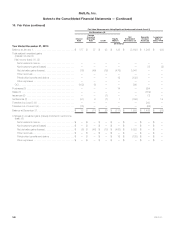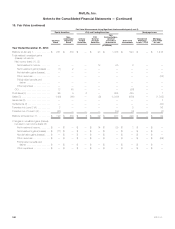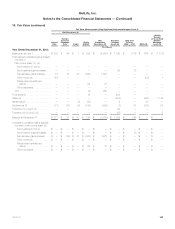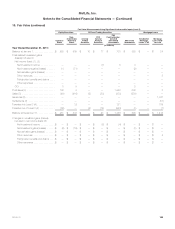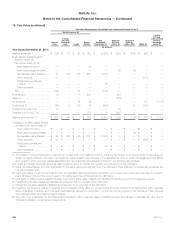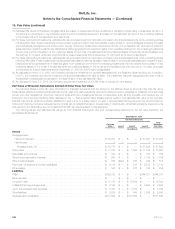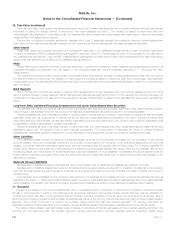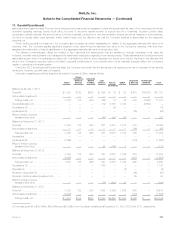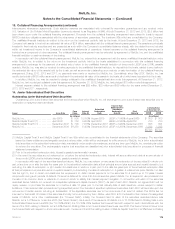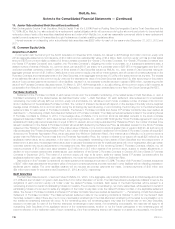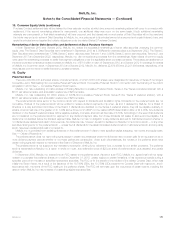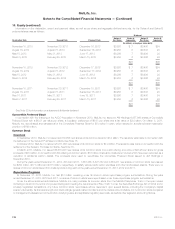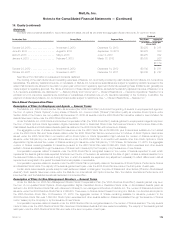MetLife 2013 Annual Report Download - page 178
Download and view the complete annual report
Please find page 178 of the 2013 MetLife annual report below. You can navigate through the pages in the report by either clicking on the pages listed below, or by using the keyword search tool below to find specific information within the annual report.
MetLife, Inc.
Notes to the Consolidated Financial Statements — (Continued)
10. Fair Value (continued)
Amounts recoverable under ceded reinsurance agreements, which the Company has determined do not transfer significant risk such that they are
accounted for using the deposit method of accounting, have been classified as Level 3. The valuation is based on discounted cash flow
methodologies using significant unobservable inputs. The estimated fair value is determined using interest rates determined to reflect the appropriate
credit standing of the assuming counterparty.
The amounts on deposit for derivative settlements, classified within Level 2, essentially represent the equivalent of demand deposit balances and
amounts due for securities sold are generally received over short periods such that the estimated fair value approximates carrying value.
Other Assets
These other assets are principally comprised of a receivable for cash paid to an unaffiliated financial institution under the MetLife Reinsurance
Company of Charleston (“MRC”) collateral financing arrangement described in Note 13. The estimated fair value of the receivable for the cash paid to
the unaffiliated financial institution under the MRC collateral financing arrangement is determined by discounting the expected future cash flows using a
discount rate that reflects the credit rating of the unaffiliated financial institution.
PABs
These PABs include investment contracts. Embedded derivatives on investment contracts and certain variable annuity guarantees accounted for as
embedded derivatives are excluded from this caption in the preceding tables as they are separately presented in “— Recurring Fair Value
Measurements.”
The investment contracts primarily include certain funding agreements, fixed deferred annuities, modified guaranteed annuities, fixed term payout
annuities and total control accounts. The valuation of these investment contracts is based on discounted cash flow methodologies using significant
unobservable inputs. The estimated fair value is determined using current market risk-free interest rates adding a spread to reflect the nonperformance
risk in the liability.
Bank Deposits
Due to the frequency of interest rate resets on customer bank deposits held in money market accounts, the Company believes that there is minimal
risk of a material change in interest rates such that the estimated fair value approximates carrying value. For time deposits, the Company has taken into
consideration the sale price for the disposition of the depository business of MetLife Bank to determine the estimated fair value of bank deposits. See
Note 3.
Long-term Debt, Collateral Financing Arrangements and Junior Subordinated Debt Securities
The estimated fair values of long-term debt and junior subordinated debt securities are principally determined using market standard valuation
methodologies. Capital leases, which are not required to be disclosed at estimated fair value are excluded from the preceding tables.
Valuations classified as Level 2 are based primarily on quoted prices in markets that are not active or using matrix pricing that use standard market
observable inputs such as quoted prices in markets that are not active and observable yields and spreads in the market. Instruments valued using
discounted cash flow methodologies use standard market observable inputs including market yield curve, duration, call provisions, observable prices
and spreads for similar publicly traded or privately traded issues.
Valuations classified as Level 3 are based primarily on discounted cash flow methodologies that utilize unobservable discount rates that can vary
significantly based upon the specific terms of each individual arrangement. The determination of estimated fair values of collateral financing
arrangements incorporates valuations obtained from the counterparties to the arrangements, as part of the collateral management process.
Other Liabilities
Other liabilities consist primarily of interest and dividends payable, amounts due for securities purchased but not yet settled, funds withheld
amounts payable, which are contractually withheld by the Company in accordance with the terms of the reinsurance agreements, and amounts
payable under certain assumed reinsurance agreements, which are recorded using the deposit method of accounting. The Company evaluates the
specific terms, facts and circumstances of each instrument to determine the appropriate estimated fair values, which are not materially different from
the carrying values, with the exception of certain deposit type reinsurance payables. For such payables, the estimated fair value is determined as the
present value of expected future cash flows, which are discounted using an interest rate determined to reflect the appropriate credit standing of the
assuming counterparty.
Separate Account Liabilities
Separate account liabilities represent those balances due to policyholders under contracts that are classified as investment contracts.
Separate account liabilities classified as investment contracts primarily represent variable annuities with no significant mortality risk to the Company
such that the death benefit is equal to the account balance, funding agreements related to group life contracts and certain contracts that provide for
benefit funding.
Since separate account liabilities are fully funded by cash flows from the separate account assets which are recognized at estimated fair value as
described in the section “— Recurring Fair Value Measurements,” the value of those assets approximates the estimated fair value of the related separate
account liabilities. The valuation techniques and inputs for separate account liabilities are similar to those described for separate account assets.
11. Goodwill
Goodwill is the excess of cost over the estimated fair value of net assets acquired. Goodwill is not amortized but is tested for impairment at least
annually or more frequently if events or circumstances, such as adverse changes in the business climate, indicate that there may be justification for
conducting an interim test. Step 1 of the goodwill impairment process requires a comparison of the fair value of a reporting unit to its carrying value. In
performing the Company’s goodwill impairment tests, the estimated fair values of the reporting units are first determined using a market multiple valuation
approach. When further corroboration is required, the Company uses a discounted cash flow valuation approach. For reporting units which are
particularly sensitive to market assumptions, the Company may use additional valuation methodologies to estimate the reporting units’ fair values.
The market multiple valuation approach utilizes market multiples of companies with similar businesses and the projected operating earnings of the
reporting unit. The discounted cash flow valuation approach requires judgments about revenues, operating earnings projections, capital market
170 MetLife, Inc.


